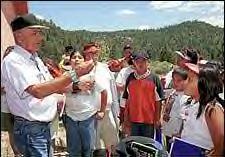|
|
Canku Ota |
|
|
(Many Paths) |
||
|
An Online Newsletter Celebrating Native America |
||
|
July 28, 2001 - Issue 41 |
||
|
|
||
|
Culture Camp |
||
|
by Nathan J. Tohtsoni -The Navajo Times-July 5, 2001 |
||
|
Times photo -Paul Natonabah |
 LAKE
ASAAYI, N.M. - Like a proud grandfather sharing knowledge gained over a lifetime, Mike Mitchell of Tsaile, Ariz.,
forged a path in the woods as about 50 adults and children followed him. LAKE
ASAAYI, N.M. - Like a proud grandfather sharing knowledge gained over a lifetime, Mike Mitchell of Tsaile, Ariz.,
forged a path in the woods as about 50 adults and children followed him.He pointed out the significance in Navajo culture of the many shrubs and herbs found along the base of the Chuska Mountains. Most of the wisdom was in the Navajo language with a sprinkle of English. The English words attracted brief attention from the young non-Navajo speakers who were off exploring away from the main body of onlookers. Mitchell talked of the plants' Navajo names and its uses whether for food, medicine or rug weaving. The group is attending a student and parent symposium at Lake Asaayi. The symposium is an eight-day camp that includes culture-related activities in the Navajo language. The camp began Sunday, July 1, and concludes Sunday, July 8, in the seclusion of the mountain camp, located eight miles south of Crystal, N.M. The Navajo Bilingual Advantage Project from the Fort Defiance Agency, utilizing a grant from the U.S. Department of Education, is sponsoring the camp. The grant covers 18 Bureau of Indian Affairs and grant schools in portions of the Chinle, Fort Defiance and Western agencies. Louann Jones, fourth-grade teacher at Pine Springs (Ariz.) Day School, attended with two co-workers and eight students including her 9-year-old daughter Brittney. "They're always telling us to teach culture to the kids and a lot of times we don't know the answer," Jones said. "Even if we've heard it before, it's been a long time. Things like this help us remember." The symposium includes cultural activities like a morning run, Navajo games, archery, a sweatlodge presentation, a day at a traditional home, field trip on tribal government, traditional foods and how technology is integrated into Navajo studies. "This is a good experience for the kids," Lillie Morrison, third-grade teacher assistant at Pine Springs, said. "It's a good way for them to learn." Each of the young campers is encouraged to keep a written journal. Brittney Jones hesitantly showed her journal. She had written down the Navajo names of the plants Mitchell shared with the group. "It's a little fun," Jones said. "But I like sitting in the classroom where I can go to sleep." Although unsure of its meaning, 13-year-old Michael Lomaintewa of Crystal liked the early morning run. "It's for your health - plus it's the Navajo way," Lomaintewa said. "It's been fun, I've learned a lot about the plants." Inez Nez of the Navajo Bilingual Advantage Project said the young campers should walk away from the symposium with respect for Navajo culture and the knowledge it takes to weave a rug. "A lot of times, people say 'Oh, it's only grandma just weaving a rug,'" Nez said. "They don't know it includes geometry, botany, social studies and history. The history includes the story of Spider Women and the language and songs. It's not just an arts and craft." The federal education grant mandates that Navajo Bilingual Advantage Project get parents involved in their child's education. "If the kids are going to learn culturally, we want the parents involved ... involved as a leader and to reinforce teaching at home," Nez said. "It's them teaching the kids, not us teaching their kids." Other components include a mentor teacher program for the 18 schools, which helps teachers getting endorsed as a bilingual instructor. Also a parent institute, scheduled for July 22-28 at Dine College in Tsaile, allows parents to gain three hours of college credit in cultural studies. |
|
|
|
Navajo Nation |
|
|
||
|
|
||
| Canku Ota is a free Newsletter celebrating Native America, its traditions and accomplishments . We do not provide subscriber or visitor names to anyone. Some articles presented in Canku Ota may contain copyright material. We have received appropriate permissions for republishing any articles. Material appearing here is distributed without profit or monetary gain to those who have expressed an interest. This is in accordance with Title 17 U.S.C. section 107. | ||
|
Canku Ota is a copyright © 2000, 2001 of Vicki Lockard and Paul Barry. |
||
|
|
|
|
|
The "Canku Ota - A Newsletter Celebrating Native America" web site and its design is the |
||
|
Copyright © 1999, 2000, 2001 of Paul C. Barry. |
||
|
All Rights Reserved. |
||

